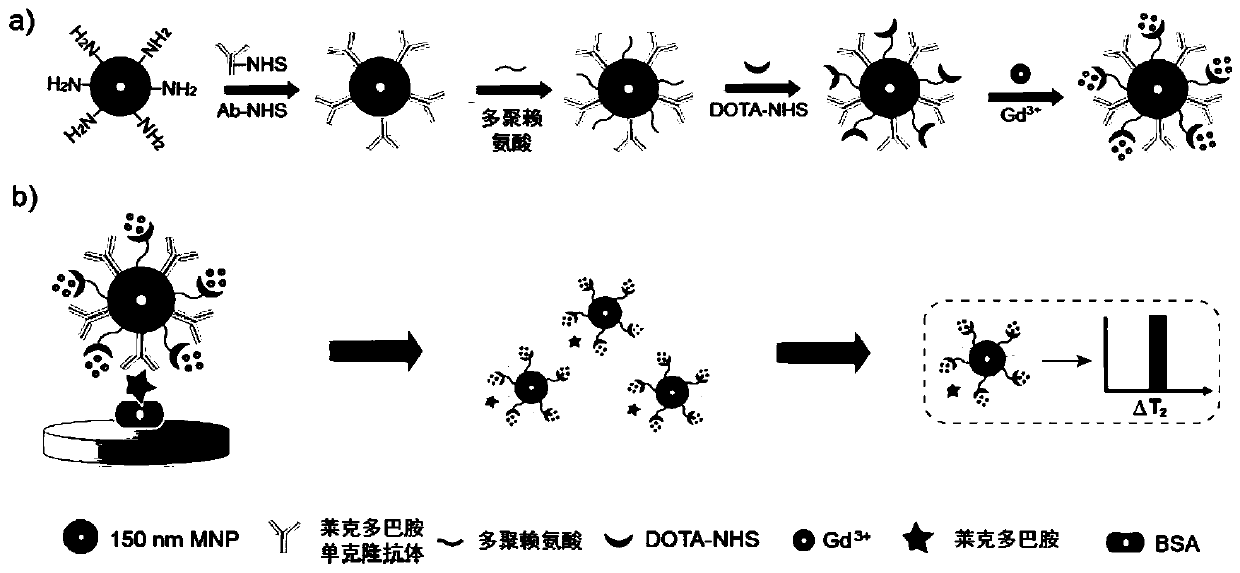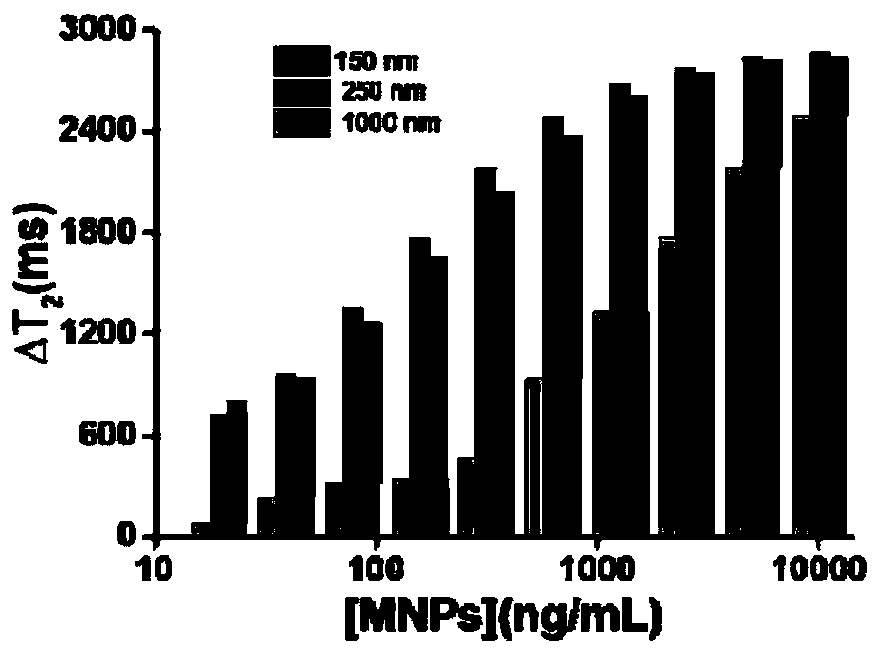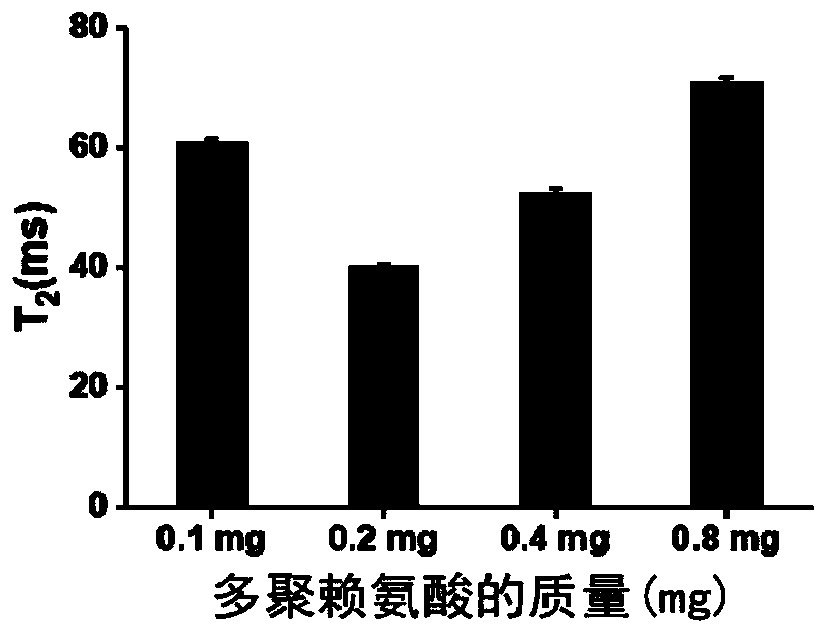Magnetic signal probe of magnetic relaxation time immunosensor and application of magnetic signal probe
An immune sensor and magnetic signal technology, applied in the field of magnetic relaxation time immune sensor detection, can solve the problems that cannot meet the detection of trace harmful substances in complex samples, lack of magnetic signal probes, poor stability, etc., and achieve improved detection Efficiency and stability, broad application prospects, and multiple amplification effects
- Summary
- Abstract
- Description
- Claims
- Application Information
AI Technical Summary
Problems solved by technology
Method used
Image
Examples
Embodiment 1
[0053] Example 1. Preparation of multifunctional nano-magnetic probes in this magnetic relaxation immunosensor
[0054] (1) "Ab-MNP 150 - Preparation of polylysine" conjugates
[0055] Add 20 μL EDC (10 mg / ml) and 10 μL NHS (10 mg / ml) to 100 μL ractopamine monoclonal antibody (Ab) solution (2.5 mg / mL), and vortex slowly at room temperature for 5-15 minutes. Add 500 μL MNP to the above mixed solution 150 (2mg / mL), and slowly vortex the reaction for 50-60min. Remove unreacted antibody by magnetic separation, and resuspend with 500 μL PBS (0.01M, pH=7.4) buffer to obtain Ab-MNP 150 Conjugates. Add 20μL EDC (10mg / ml) and 10μL NHS (10mg / ml) to 100μL polylysine (20mg / mL) solution, shake slowly for 10-20min, then add to the Ab-MNP 150 In the conjugate resuspension solution, slowly vortex the reaction for 1-2h. Remove unreacted polylysine by magnetic separation, and finally wash and resuspend with PBS (0.01M, pH=7.4) buffer to obtain Ab-MNP 150 - Polylysine conjugates, stored a...
Embodiment 2
[0069] Example 2. The construction of this magnetic relaxation immunosensor and the comparison with the sensitivity of traditional methods
[0070] 100 μL ractopamine complete antigen (50 μg / mL) was coated on an ELISA plate, incubated at 37° C. for 1-2 h, washed 2-4 times with PBST (0.05% Tween-20) buffer, and set aside. 100 μL Ab-MNP 150 -Polylysine-DOTA-Gd 3+ The magnetic probe was added into a gradient concentration of ractopamine (Rac) standard solution, and reacted at 37°C for 15-20min. Rac-Ab-MNP obtained by magnetic separation 150 -Polylysine-DOTA-Gd 3+ Conjugate and unreacted Ab-MNP 150 -Polylysine-DOTA-Gd 3+ Magnetic probes, and add them to the above ELISA plate, and react at room temperature for 20-60min. Wash 2-4 times with PBST buffer to remove unreacted Ab-MNP 150 -Polylysine-DOTA-Gd 3+ magnetic probe. Then add 200 μ L of PBST (5% Tween-20) buffer, keep 3min, collect the eluate, and carry out T 2 Determination of the signal.
[0071] In this embodiment,...
Embodiment 3
[0073] Embodiment 3. The determination of specificity and recovery rate of this magnetic relaxation immunosensor
[0074] (1) In the specificity test, clenbuterol, albuterol, chloramphenicol, and neomycin were used as interfering substances to test the sensitivity of the sensor. The concentrations of these analogs were 10 ng / mL and the concentration of ractopamine was 0.5 ng / mL. Such as Figure 12 As shown, only ractopamine can induce T 2 Significant changes in the value, other analogues have a negligible effect on the magnetic signal.
[0075] 2) The recovery rate was studied by the standard addition method, that is, different concentrations of ractopamine (0, 0.05, 0.1, 0.5, 1, 5, 10, 50, 100 ng / mL) were added to the blank sample. As shown in Table 1, the detection recovery rate (90%-110%) of ractopamine also shows the accuracy of the method.
[0076] Table 1. The sensor detects the recovery rate of ractopamine in the blank sample
[0077] Added concentration o...
PUM
| Property | Measurement | Unit |
|---|---|---|
| particle diameter | aaaaa | aaaaa |
| particle diameter | aaaaa | aaaaa |
| molecular weight | aaaaa | aaaaa |
Abstract
Description
Claims
Application Information
 Login to View More
Login to View More - R&D
- Intellectual Property
- Life Sciences
- Materials
- Tech Scout
- Unparalleled Data Quality
- Higher Quality Content
- 60% Fewer Hallucinations
Browse by: Latest US Patents, China's latest patents, Technical Efficacy Thesaurus, Application Domain, Technology Topic, Popular Technical Reports.
© 2025 PatSnap. All rights reserved.Legal|Privacy policy|Modern Slavery Act Transparency Statement|Sitemap|About US| Contact US: help@patsnap.com



